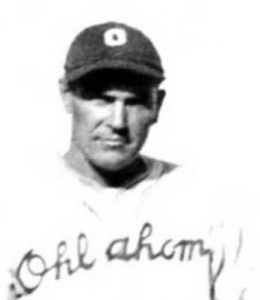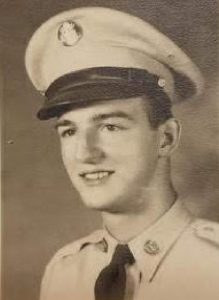 Gov. Matt Bevin today recognized the sacrifice of a Kentucky sailor who died in World War II, but whose remains have just been positively identified.
Gov. Matt Bevin today recognized the sacrifice of a Kentucky sailor who died in World War II, but whose remains have just been positively identified.
The Defense POW/MIA Accounting Agency (DPAA) has announced that Navy Machinist’s Mate 1st Class Ulis C. Steely, 25, of Corbin, Kentucky, was officially accounted for on Oct. 15, 2018.
On Dec. 7, 1941, Steely was assigned to the battleship USS Oklahoma, which was moored at Ford Island, Pearl Harbor, when the ship was attacked by Japanese aircraft. The USS Oklahoma sustained multiple torpedo hits, which caused it to quickly capsize. The attack on the ship resulted in the deaths of 429 crewmen, including Steely.
From December 1941 to June 1944, Navy personnel recovered the remains of the deceased crew, which were subsequently interred in the Halawa and Nu’uanu Cemeteries.
In September 1947, tasked with recovering and identifying fallen U.S. personnel in the Pacific Theater, members of the American Graves Registration Service (AGRS) disinterred the remains of U.S. casualties from the two cemeteries and transferred them to the Central Identification Laboratory at Schofield Barracks. The laboratory staff was only able to confirm the identifications of 35 men from the USS Oklahoma at that time. The AGRS subsequently buried the unidentified remains in 46 plots at the National Memorial Cemetery of the Pacific (NMCP), known as the Punchbowl, in Honolulu. In October 1949, a military board classified those who could not be identified as non-recoverable, including Steely.
Between June and November 2015, DPAA personnel exhumed the USS Oklahoma Unknowns from the Punchbowl for analysis.
To identify Steely’s remains, scientists from DPAA used dental and anthropological analysis. Additionally, scientists from the Armed Forces Medical Examiner System used mitochondrial DNA (mtDNA,) analysis.
DPAA is grateful to the Department of Veterans Affairs and the Department of the Navy for their partnership in this mission.
Of the 16 million Americans who served in World War II, more than 400,000 died during the war. Currently there are 72,674 still unaccounted for from World War II, of which approximately 30,000 are assessed as possibly-recoverable. Steely’s name is recorded on the Walls of the Missing at the Punchbowl, along with the others who are missing from WWII. A rosette will be placed next to his name to indicate he has been accounted for.
For family information, contact the Navy Service Casualty office at 800-443-9298.
Steely will be buried Oct. 5, 2019, in his hometown of Corbin, and Gov. Bevin will order flags lowered to half-staff in his honor on that date.
 Gov. Matt Bevin today recognized the sacrifice of a Kentucky soldier who died in the Korean War, but whose remains have just been positively identified and are in the process of being returned to his family in Irvington.
Gov. Matt Bevin today recognized the sacrifice of a Kentucky soldier who died in the Korean War, but whose remains have just been positively identified and are in the process of being returned to his family in Irvington.
Army Pvt. Robert J. Sipes, Jr., 19, died on Nov. 30, 1950, was accounted for on Oct. 23, 2018, and will be buried in his hometown on December 5, 2018.
In November 1950, Sipes was a member of Company L, 3rd Battalion, 7th Cavalry Regiment, 1st Cavalry Division. He was killed in action on Nov. 30, 1950, during heavy fighting between the Chinese People’s Volunteer Forces (CPVF) and the 7th Cavalry Regiment near the village of Unsan, North Korea. His remains were processed through a 7th Cavalry Regiment Collection Station on Dec. 1, 1950, and interred at the United Nations Military Cemetery (UNMC) Pyongyang on Dec. 2, 1950.
On Aug. 17, 1954, the United Nations Command (UNC) and North Korea, along with the CPVF, reached an agreement regarding the recovery and return of war dead. The agreement, known as Operation Glory, resulted in the turnover of 4,200 sets of remains to the UNC, including more than 400 sets reportedly disinterred from Pyongyang. One set of remains, designated N-16678 could not be identified, and was subsequently interred at the National Memorial Cemetery of the Pacific in Honolulu (known as the Punchbowl), as an Unknown.
In June 2017, Defense POW/MIA Accounting Agency (DPAA) disinterred Unknown X-16678 for identification.
To identify Sipes’ remains, scientists from DPAA and the Armed Forces Medical Examiner System used mitochondrial DNA (mtDNA) analysis, dental, anthropological, and chest radiograph comparison analysis, as well as circumstantial and material evidence.
Service arrangements for Pvt. Sipes are not yet complete.
 Weather
Weather Traffic
Traffic @LouisvilleDispatch
@LouisvilleDispatch @LouisvilleDisp
@LouisvilleDisp Subscribe
Subscribe